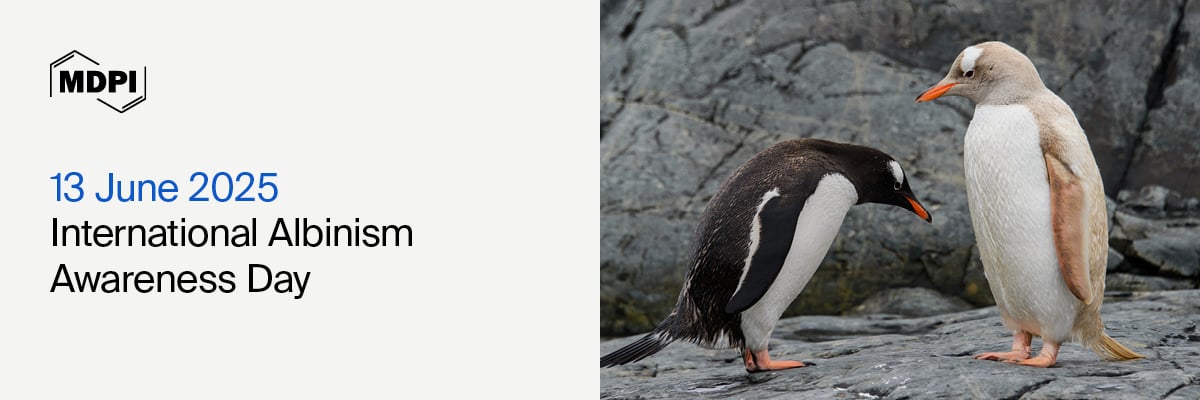
Journal Menu
► ▼ Journal Menu-
- Diagnostics Home
- Aims & Scope
- Editorial Board
- Reviewer Board
- Topical Advisory Panel
- Instructions for Authors
- Special Issues
- Topics
- Sections & Collections
- Article Processing Charge
- Indexing & Archiving
- Editor’s Choice Articles
- Most Cited & Viewed
- Journal Statistics
- Journal History
- Journal Awards
- Society Collaborations
- Conferences
- Editorial Office
Journal Browser
► ▼ Journal BrowserNeed Help?
Announcements
12 June 2025
International Albinism Awareness Day—“Demanding Our Rights: Protect Our Skin, Preserve Our Lives”, 13 June 2025

International Albinism Awareness Day 2025 underscores the urgent need for increased awareness, preventive care, and accessible healthcare for people with albinism. This year’s theme highlights the life-threatening impact of skin cancer among individuals with albinism and reinforces the importance of sun protection, early detection, and timely treatment.
Albinism is a rare, inherited genetic condition that affects the body’s ability to produce melanin, the pigment responsible for the color of our skin, hair, and eyes. People with albinism typically have very light skin and hair, alongside various vision impairments. While it is not contagious and does not affect intelligence, albinism is often misunderstood. This leads to stigmatization, discrimination, and even human rights violations in some regions where harmful myths persist.
Because they have little to no melanin, individuals with albinism are especially vulnerable to sun damage and face a significantly increased risk of developing skin cancer. Addressing this requires more than just clinical intervention—it calls for integrated healthcare policies and inclusive social systems that acknowledge both the medical and socio-political dimensions of the condition.
In recognition of this global observance, we invite you to explore a curated collection of articles and Special Issues from selected MDPI journals, including Biomedicines, Cancers, Children, Diagnostics, Genes, International Journal of Molecular Sciences, Journal of Clinical Medicine and Molecules. These open-access resources provide critical insights into the diagnosis, management, and complications of albinism, and promote cross-disciplinary collaboration between researchers, clinicians, and advocacy groups.
Together, through science, education, and empathy, we can foster a more inclusive world where people with albinism live free from discrimination and with access to the care they deserve.

 |
 |
 |
 |
 |
 |
 |
 |

“Can a Portable Flash Visual Evoked Potential (VEP) Device Identify Chiasmal Decussation Anomalies in Albinism?”
by Eloise Keeling, Perry Carter, Abdi Malik Musa, Fatima Shawkat, Helena Lee and Jay E. Self
Diagnostics 2025, 15(11), 1395; https://doi.org/10.3390/diagnostics15111395
“Common Variants in the TYR Gene with Unclear Pathogenicity as the Cause of Oculocutaneous Albinism in a Cohort of Russian Patients”
by Olga Shchagina, Anna Stepanova, Polina Mishakova, Vitaliy Kadyshev, Nina Demina, Ludmila Bessonova, Sofya Ionova, Daria Guseva, Andrey Marakhonov, Rena Zinchenko et al.
Biomedicines 2024, 12(10), 2234; https://doi.org/10.3390/biomedicines12102234
“Functional Characterization of Splice Variants in the Diagnosis of Albinism”
by Modibo Diallo, Cécile Courdier, Elina Mercier, Angèle Sequeira, Alicia Defay-Stinat, Claudio Plaisant, Shahram Mesdaghi, Daniel Rigden, Sophie Javerzat, Eulalie Lasseaux et al.
Int. J. Mol. Sci. 2024, 25(16), 8657; https://doi.org/10.3390/ijms25168657
“Genetic Linkage between CAPN5 and TYR Variants in the Context of Albinism and Autosomal Dominant Neovascular Inflammatory Vitreoretinopathy Absence: A Case Report”
by Mirjana Bjeloš, Ana Ćurić, Mladen Bušić, Benedict Rak and Biljana Kuzmanović Elabjer
Int. J. Mol. Sci. 2024, 25(12), 6442; https://doi.org/10.3390/ijms25126442
“Missing Heritability in Albinism: Deep Characterization of a Hungarian Albinism Cohort Raises the Possibility of the Digenic Genetic Background of the Disease”
by Nikoletta Nagy, Margit Pal, Jozsef Kun, Bence Galik, Peter Urban, Marta Medvecz, Beata Fabos, Alexandra Neller, Aliasgari Abdolreza, Judit Danis, Viktoria Szabo, Zhuo Yang, Stefanie Fenske, Martin Biel, Attila Gyenesei, Eva Adam and Marta Szell
Int. J. Mol. Sci. 2024, 25(2), 1271; https://doi.org/10.3390/ijms25021271
“Does Foveal Hypoplasia Affect Emmetropization in Patients with Albinism?”
by Line Kessel, Christine Dahlgren Bohnsack Kjølholm and Joaquim Torner Jordana
Children 2023, 10(12), 1910; https://doi.org/10.3390/children10121910
“Vision-Related Quality of Life in Danish Patients with Albinism and the Impact of an Updated Optical Rehabilitation”
by Kristian Lisbjerg, Joaquim Torner Jordana, Vibeke N. Brandt, Christine Kjølholm and Line Kessel
J. Clin. Med. 2023, 12(17), 5451; https://doi.org/10.3390/jcm12175451
“Skin Pigmentation Types, Causes and Treatment—A Review”
by Amin Mahmood Thawabteh, Alaa Jibreen, Donia Karaman, Alà Thawabteh and Rafik Karaman
Molecules 2023, 28(12), 4839; https://doi.org/10.3390/molecules28124839
“Report of Hermansky–Pudlak Syndrome in Two Families with Novel Variants in HPS3 and HPS4 Genes”
by Sadeeda Qaiser Zaman, Muhammad Anas, Gauhar Rehman, Qadeem Khan, Aiman Iftikhar, Mashal Ahmad, Muhammad Owais, Ilyas Ahmad, Osama Yousef Muthaffar, Angham Abdulrhman Abdulkareem et al.
Genes 2023, 14(1), 145; https://doi.org/10.3390/genes14010145
“Diagnostic Yield of Genetic Testing for Ocular and Oculocutaneous Albinism in a Diverse United States Pediatric Population”
by Kyle S. Chan, Brenda L. Bohnsack, Alexander Ing, Andy Drackley, Valerie Castelluccio, Kevin X. Zhang, Hanta Ralay-Ranaivo and Jennifer L. Rossen
Genes 2023, 14(1), 135; https://doi.org/10.3390/genes14010135

| “More than Skin Deep—Latest Advances in Congenital and Autoimmune Pigmentation Disorders” Guest Editor: Prof. Dr. Reinhart M. Speeckaert Submission deadline: 25 August 2025 |
“Melanin Pigmentation: Physiology and Pathology” Guest Editors: Prof. Dr. Shosuke Ito and Prof. Dr. Manickam Sugumaran Submission deadline: 20 October 2025 |
 |
 |




